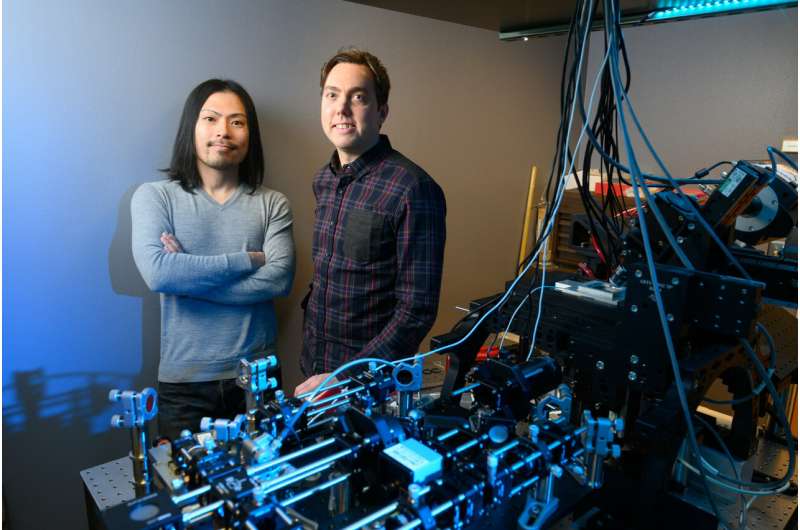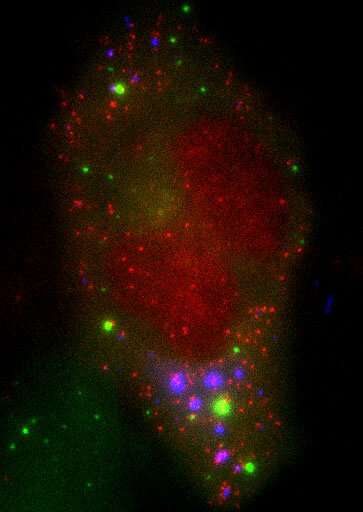Cellular stress at the movies: Biochemists illuminate a key survival mechanism in cells

Much like our fight-or-flight response, our cells also have a stress autopilot mode. An oxygen dropoff, overheating, or an invading toxin can trigger the cellular stress response – a cascade of molecular changes that are the cell's last-ditch effort to survive.
Among these survival strategies is the formation of "stress granules" – proteins and RNA molecules huddled together into membrane-less blobs when the cell is threatened. RNA is the essential biological molecule that translates genetic information from DNA to make proteins. During cellular stress, most RNA molecules stop their normal business of translation and cluster inside stress granules, as if running to hide.
In a new experiment published in Nature Cell Biology, biological imaging experts led by Tim Stasevich, assistant professor in the Department of Biochemistry and Molecular Biology at Colorado State University, have used a custom fluorescence microscope and a novel antibody tagging tool to watch living cells undergoing stress. With single-molecule precision, the researchers have captured individual RNA molecules interacting with stress granules, revealing how, when and where the RNAs move around – a process never before witnessed from start to finish. They have shown definitively, among other things, that RNA translation is completely silenced before the RNAs enter the stress granules.
The results sprung from a partnership with the lab of Roy Parker, professor in the Department of Biochemistry at University of Colorado Boulder. The two labs' combined expertise has illuminated unprecedented details of the cellular stress response, paving the way for future studies into the full dynamics of translational shutdown, and its relationship to many diseases.
"I think seeing is believing, and that's our contribution here," said Stasevich, a Boettcher Investigator whose lab previously published the biochemical tagging and imaging technique in the journal Science. "We are using live cells as test tubes to study dynamic processes that have never been seen before. The ability to image these processes at the single-molecule level in living cells will be a powerful tool to better understand the cellular stress response in normal and diseased cells."
Parker's lab at CU Boulder had long been interested in RNA interactions associated with cellular stress. "We saw Tim's Science paper on nascent chain tracking, and thought this would be the perfect technique to answer questions our lab had been trying to figure out for a while," explained CU postdoctoral researcher Stephanie Moon, co-first author on the Nature Cell Biology paper and a former CSU graduate student.
The dynamics of stress granule formation had only been inferred in previous research, Parker said. "But if cells don't make them, they die. So they must be important."
Previously, the only way scientists like Parker and Moon could "see" RNAs during cellular stress was through fixed cell imaging – the equivalent of taking a snapshot. "We knew the RNAs were in the stress granules, and we knew which RNAs were in there. We knew they could be affected by mutations that can cause disease. All that knowledge was based on static images," Parker said.
According to earlier research by Parker, several mutations can cause such RNA-protein assemblies to form incorrectly, and these aberrations are linked to neurodegenerative diseases like Amyotrophic Lateral Sclerosis.
By going to the movies with Stasevich's team, the cellular stress response has come alive in colorful detail, shedding light on previously hidden details. Among the paper's major findings is that while some RNAs come and go at the surfaces of the granules, some are peculiarly stuck, as if tethered in molasses, the researchers said.
"By showing that RNAs go to a granule, are translationally repressed, and they stay there, it suggests that the stress granules may have a role in keeping those RNAs out of gene expression," Moon said.
Tatsuya Morisaki, co-first author and a senior researcher in Stasevich's lab, led the imaging experiments with Moon and developed the translation tracking technique. Morisaki used a cell line developed by Parker's lab that contains a green fluorescent marker for stress granules. The Stasevich lab's fluorescent labeling technology altered the cell line with markers that fluoresce far-red for RNA, and red for translation, allowing all three colors to be seen at once.

Stasevich called the collaboration a beautiful combination of two labs, moving toward a common goal. "I think we can really work together to answer some questions that have never been answered before," Stasevich said.
Parker agreed.
"Tim's lab is terrific at single-molecule imaging, including translation and RNA localization, while my group is interested in trying to understand these RNA-protein granules and how they form," he added. "This is how science should work.
More information: Stephanie L. Moon et al. Multicolour single-molecule tracking of mRNA interactions with RNP granules, Nature Cell Biology (2019). DOI: 10.1038/s41556-018-0263-4
T. Morisaki et al. Real-time quantification of single RNA translation dynamics in living cells, Science (2016). DOI: 10.1126/science.aaf0899
Journal information: Nature Cell Biology , Science
Provided by Colorado State University


















